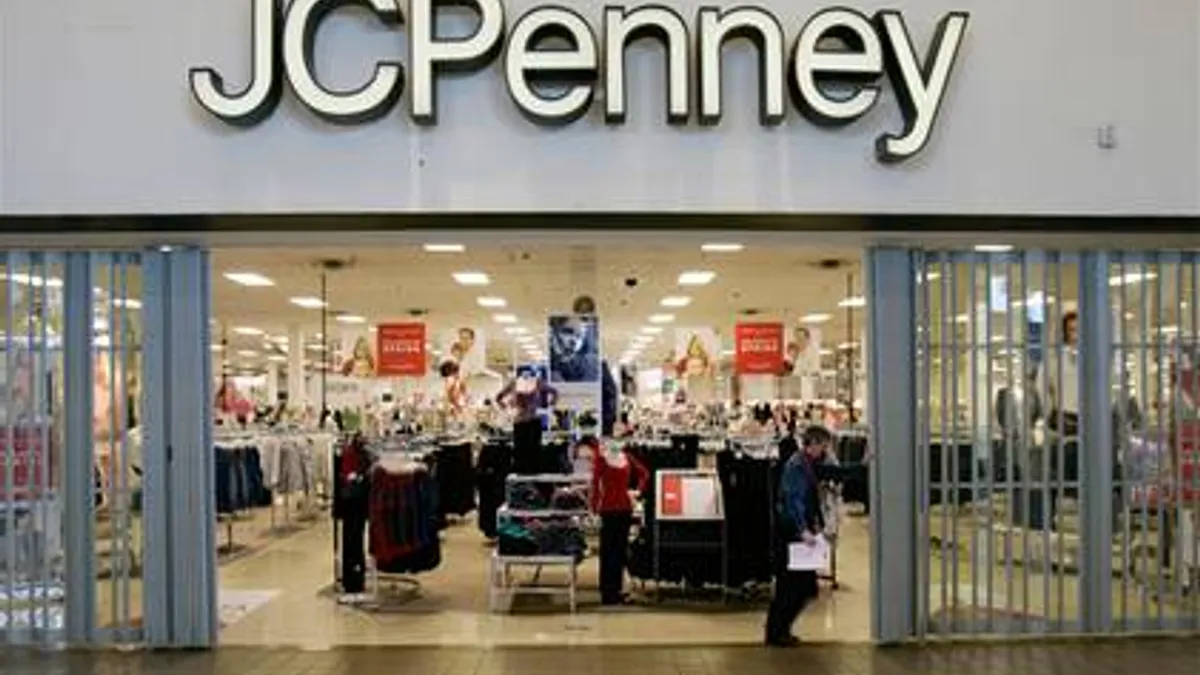UPDATE: December 3, 2019: J.C. Penney is back in compliance with the New York Stock Exchange, the company reported Monday. The NYSE warned Penney in August that it was at risk of being dropped from the exchange following a dip in the company’s average share price below $1. The retailer regained compliance after its stock rose above the dollar mark for more than 30 consecutive trading days.
Penney shares got boosts this fall as it announced it was launching an outdoor private label apparel line for men, unveiled a re-imagined store and reported improved profit metrics in the third quarter. The retailer’s stock traded at $1.10 at publication time.
Dive Brief:
-
J.C. Penney on Thursday said the New York Stock Exchange Aug. 6 notified the company that it is no longer in compliance with continued-listing criteria, which require an average closing share price of at least $1 for 30 straight trading days. The rules allow its common stock to be listed and traded while it rights the situation, subject to compliance with other continued-listing requirements, according to a company press release.
-
NYSE rules dictate that the company regain compliance within six months of the notice or by its next annual shareholder meeting if stockholder approval is required to cure the share-price non-compliance. That would be true if the retailer opts for a reverse stock split to boost the price.
-
Penney said it "plans to notify the NYSE within 10 business days of receipt of the notification of its intent to cure the deficiency." The notification doesn’t affect business operations or Securities and Exchange Commission reporting rules, nor does it conflict with or cause any default under any of its material debt or other agreements, according to the release.
Dive Insight:
This NYSE notice heaps one more task onto J.C. Penney's plate as the retailer continues its turnaround effort, now a years-long struggle.
Last month the retailer confirmed in an email to Retail Dive that it was working with outside advisers, though it stressed it was not for bankruptcy prep. "By working with some of the best firms in the industry, we are taking positive and proactive measures, as we have done in the past, to improve our capital structure and the long-term health of our balance sheet," the retailer said.
The company also said then that it has "no significant debt maturities coming due in the near term, and we continue to maintain a strong liquidity position. Also, given our strong liquidity position, we can confirm that we have not hired any advisors to prepare for an in-court restructuring or bankruptcy."
Still, the department store has long-term debt of $3.8 billion and quarterly interest expenses of $73 million, as of the first quarter, and was downgraded by Moody's at the end of May. Beyond its financial situation, the retailer continues to grapple with retail fundamentals, with limited success so far.
The company's department store model fallen out of favor, plus it has too many stores, too often in sub-par malls. Since the arrival of Jill Soltau as CEO late last year from crafts retailer Joann, after the sudden exit of Marvin Ellison, the retailer has brought in a new CFO, head of stores and women's apparel chief, among other c-suite changes. In a May first-quarter earnings call Soltau emphasized the company's efforts to forge a strategic plan, reduce inventory, retool its assortment and fill out its management ranks.
The retailer is also among those warning that tariff hikes could hobble it further, saying in June that proposed tariffs would hurt Penney's core customer, middle-class women who shop for their families on a "marginally" higher household income than the U.S. median. The retailer also pointed out that apparel and footwear tariffs are already high relative to other products, and that the costs of the new duties would inevitably fall on U.S. shoppers. Both Penney and Macy's then also noted how difficult it would be to shift their supply chains away from Chinese manufacturers, maintaining that just 2% of shoes sold in the U.S. are made domestically and that they are unaware of any U.S.-based sweater makers.















